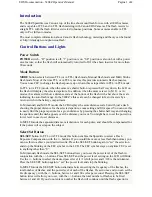
- 62 -
9
Glossary of Terms
ActiveX -
A standard that enables software components to interact with one another in a networked environment, regardless of the
language(s) used to create them. web browsers may come into contact with ActiveX controls, ActiveX documents, and ActiveX
scripts. ActiveX controls are often downloaded and installed automatically as required.
ARP (Address Resolution Protocol) -
This protocol is used to associate an IP address to a hardware MAC address. A request is broadcast on the local network to
discover the MAC address for an IP address.
Autoiris (DC-Iris) -
This special type of iris is electrically controlled by the camera, to automatically regulate the amount of light allowed to enter.
Bitmap -
A bitmap is a data file representing a rectangular grid of pixels. It defines a display space and color for each pixel (or ‘bit’) in the
display space. This type of image is known as a ‘raster graphic.’ GIFs and JPEGs are examples of image file types that contain
bitmaps.
Because a bitmap uses this fixed raster method, it cannot easily be rescaled without losing definition. Conversely, a vector graphic
image uses geometrical shapes to represent the image, and can thus be quickly rescaled.
Bit rate -
The bit rate (in kbit/s or Mbit/s) is often referred to as speed, but actually defines the number of bits/time unit and not
distance/time unit.
Bonjour -
Also known as zero-configuration networking, Bonjour enables devices to automatically discover each other on a network,
without having to enter IP addresses or configure DNS servers. Bonjour is a trademark of Apple Computer, Inc.
Broadband -
In network engineering terms, this describes transmission methods where two or more signals share the same carrier. In more
popular terminology, broadband is taken to mean high-speed data transmission.
CCD (Charged Coupled Device) -
This light-sensitive image device used in many digital cameras is a large integrated circuit that contains hundreds of thousands of
photo-sites (pixels) that convert light energy into electronic signals. Its size is measured diagonally and can be 1/4", 1/3", 1/2" or
2/3".
CGI (Common Gateway Interface) -
A specification for communication between a web server and other (CGI) programs. For example, a HTML page that contains a
form might use a CGI program to process the form data once it is submitted.
CIF (Common Intermediate Format) -
CIF refers to the analog video resolutions 352x288 pixels (PAL) and 352x240 pixels (NTSC). See also Resolution.
Client/Server -
Client/server describes the relationship between two computer programs in which one program, the client, makes a service
request from another program, the server, which fulfils the request. Typically, multiple client programs share the services of a
common server program. A web browser is a client program that requests services (the sending of web pages or files) from a web
server.
CMOS (Complementary Metal Oxide Semiconductor) -
A CMOS is a widely used type of semiconductor that uses both negative and positive circuits. Since only one of the circuit types is
on at any given time, CMOS chips require less power than chips using just one type of transistor. CMOS image sensors also allow
processing circuits to be included on the same chip, an advantage not possible with CCD sensors, which are also much more
expensive to produce.
Codec -
In communications engineering, a codec is usually a coder/decoder. Codecs are used in integrated circuits or chips that convert
e.g. analog video and audio signals into a digital format for transmission. The codec also converts received digital signals back into
analog format. A codec uses analog-to-digital conversion and digital-to-analog conversion in the same chip.
Codec can also mean compression/decompression, in which case it is generally taken to mean an algorithm or computer program








































